 |
Focus features two in-depth reviews each month of fine art, architecture and design exhibitions and events at art museums, galleries and alternative spaces around Japan. The contributors are non-Japanese art critics living in Japan. |
|
|
 |
 |
 |
A Doll's House: The Living National Treasures Museum
Alice Gordenker |
 |
|
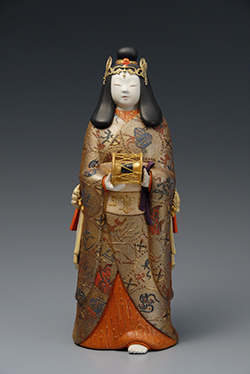 |
|
|
|
Tenko (Heavenly Drum) by doll maker Ryujo Hori, who was designated a Living National Treasure in 1955.
|
Collectors are a special breed, often acquiring things according to a logic all their own. This is how the world gained institutions as eclectic and varied as the Salt and Pepper Shaker Museum and the Dog Collar Museum. So as guiding principles for acquisition go, a decision to focus on artists recognized by their own government as preservers of the nation's cultural heritage seems remarkably well considered. The results can be seen in a small but nevertheless impressive museum in the seaside resort of Yugawara, less than two hours by train from Tokyo.
The Living National Treasures Museum (Ningen Kokuho Bijutsukan in Japanese) was founded in 2007 to house the art collection of Nobuhiro Yamaguchi, a local entrepreneur who continues to serve as the museum's chairman. The building itself is nothing special, with galleries spread over three small floors, but the museum very nicely brings together the work of some of the most celebrated Japanese traditional craft artists of the 20th century.
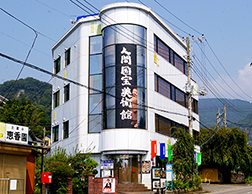 |
|
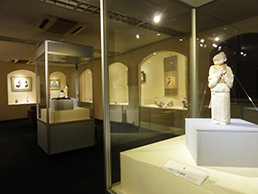 |
|
The Living National Treasures Museum in Yugawara, Kanagawa Prefecture, and a view inside the current special exhibition of dolls. |
In 1950, amid concern that the nation's cultural patrimony was losing ground to Westernization, the Japanese government set up a system to identify and support individuals with key skills in traditional crafts and performing arts. The enabling legislation doesn't actually use the wording "Living National Treasure" -- that was coined by a newspaper reporter -- but the term has been widely adopted as snappier and easier to remember than the official wording ("Preserver of Important Intangible Cultural Properties"). In crafts alone, more than 175 individuals have been certified to date in eight categories including ceramics, textiles, lacquerware, and doll making. The designation comes with an annual stipend that ends upon death, but the benefits to fame and reputation remain.
|
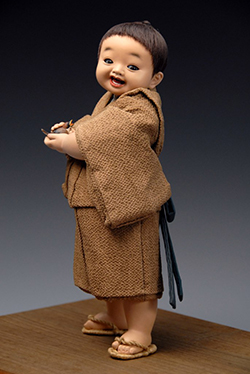 |
|
|
|
Koyorokobu by Goyo Hirata. |
The museum exhibits about 200 works at any one time, with themed shows that change three times a year. The current special exhibition, which runs through May 27, pairs some 60 masterpieces of traditional doll making with paintings from the museum's collection. There is no Living National Treasure designation in painting, but the artists represented are well known, including Shinsui Ito (1898-1972), Kiyokata Kaburaki (1878-1972), and Yumeji Takehisa (1884-1934.) Dolls currently on display include an amazingly lifelike depiction of a toddler holding a sparrow, skillfully crafted by Goyo Hirata (1903-81), who was designated a Living National Treasure in 1955. Titled Koyorokobu ("Happy Child"), this charming work is one of the museum's most popular exhibits, to the point that visitors complain when it's not on view. This exhibition is also a good opportunity to see a number of works by celebrated doll makers Ryujo Hori (1897-1984) and Juzo Kagoshima (1898-1982).
 |
|
 |
|
Some of the outstanding ceramic pieces in the museum's collection. Left, a large bowl with camellia design by Rosanjin Kitaoji, and right, Yosaikaki (Aurora Vase) by Yasokichi Tokuda (1933-2009), who was designated a Living National Treasure in 1997. |
As you'd expect at a museum with this name, most of what you'll see on any visit will indeed be the work of Living National Treasures. But there are exceptions. One example, frequently on display and worth the trip for its own sake, is a large ceramic bowl with a design of camellia flowers made by Rosanjin Kitaoji (1883-1959). A man of many talents, and hugely influential in his time, Rosanjin was offered the Living National Treasure designation in 1955 but was one of the few artists to decline the honor. The museum also holds a significant collection of the work of Morihiro Hosokawa (b. 1938), who served as prime minister of Japan in 1993 and 1994. Though not a Living National Treasure, Hosokawa is something of a local artist, as he maintains a studio in Yugawara.
What really sets this museum apart, however, is the opportunity it gives you to take in your hands something created by a Living National Treasure -- and actually use it. Before leaving, visitors are offered a cup of matcha green tea served in their choice of a dozen or so tea bowls from the hands of ceramic luminaries like Shoji Hamada, Toyo Kaneshige, and Jusetsu Miwa. This service is included in the reasonable cost of admission, and comes with Japanese sweets. A few of the tea bowls are for sale.
 |
|
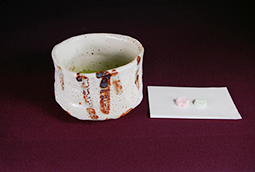 |
|
Left, a visitor enjoys a complementary bowl of matcha (photo by Alice Gordenker). Right, the Shino-ware tea bowl selected, made by Osamu Suzuki (b. 1934), designated a Living National Treasure in 1994. |
"At most museums, you can only look," comments curator Kohei Hayakawa. "But here, we want our visitors to not only see great works of art, but also to handle and use them. We even want them to take one home, if they like, which is why our museum shop includes not just the usual postcards and souvenirs, but real works by real Living National Treasures."
A few years ago, the museum began working with local communities to share its collection -- free of charge -- with people who don't normally have opportunities to experience art. Since 2012 its "Mobile Museum" program has brought art to more than 47,000 people in ten communities affected by natural disasters or economic recession. By exhibiting in schools and community centers, the program provides both children and adults the chance to view world-class art in a familiar, local setting. This month the "Mobile Museum" will make its first foray overseas, transporting a selection of fine Japanese crafts to the Art Museum of the National Taiwan University of Arts, Taipei, from April 5 to 10.
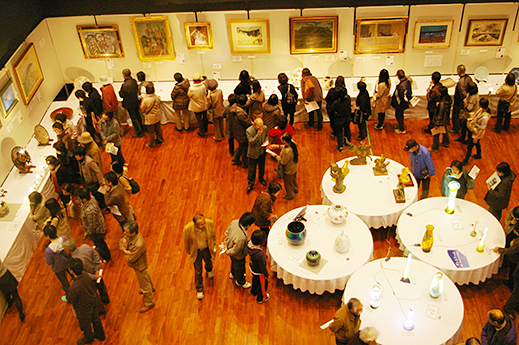 |
|
In 2014, the "Mobile Museum" program brought fine art to Ofunato in Iwate Prefecture, a community heavily damaged in the 2011 Tohoku earthquake and tsunami.
All photographs courtesy of the museum unless otherwise stated.
|
 |
| | Dolls by Living National Treasures and Famous Bijinga Paintings |
| | Living National Treasures Museum |
| | 1 February - 27 May 2016 |
| | 3-16-1 Chuo, Yugawara-cho, Ashigara Shimo, Kanagawa Prefecture
Hours: Open all year, 9:30 a.m. to 5 p.m. (last admission at 4:30 p.m.)
Phone: 0465-62-2112
Access: From Tokyo Station take the JR Tokaido Line to Yugawara (1 1/2 hours by regular train, 1 1/4 hours by Odoriko express). Or take the Shinkansen from Tokyo to Odawara (35 minutes), or the Odakyu Odawara Line from Shinjuku to Odawara (1 hour 12 minutes by super express), and change to the Tokaido Line for the local JR train to Yugawara (16 minutes). The museum is a 15-minute walk from Yugawara Station. Or take the Hakone Tozan bus from stop #3, bound for Kajiya, and get off at Yamazaki directly in front of the museum. |
|
 |
 |
Alice Gordenker
Alice Gordenker is a writer and translator based in Tokyo, where she has lived for more than 17 years. For over a decade, she penned the "So, What the Heck Is That?" column for The Japan Times, providing in-depth reports on everything from industrial safety to traditional talismans. She translates and consults for museums, and has a special interest in making Japanese museums more accessible for visitors from other countries. |
|
 |
|